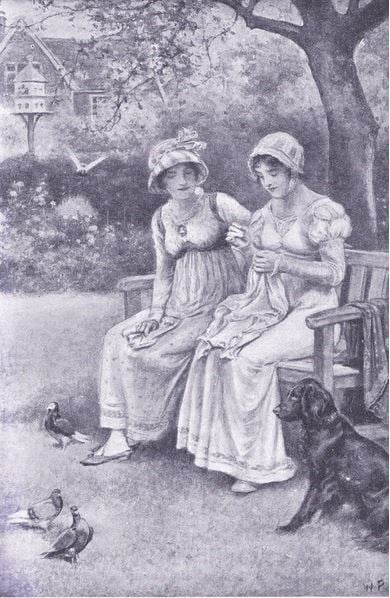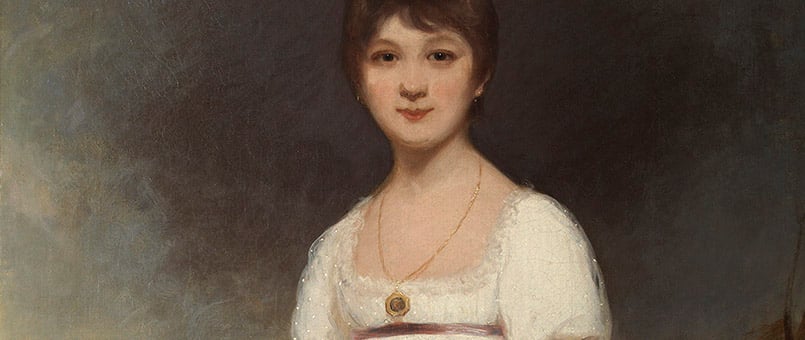
Celebrating the 200th anniversary of Jane Austen, the new face of the £10 note
The 18th of July 2017 will mark two centuries since the death of one of England’s most famous and revered authors. In tribute to Jane Austen, the Bank of England has confirmed that the writer will be honoured as the face of the new polymer £10 note.
Austen came of age in England’s Georgian era, a time of immense social and artistic change. Besides the biting ironic voice and social commentary that pervades her novels, not too much is known about the biography of the female writer; only 160 of the approximately 3,000 letters she wrote in her lifetime survive today. So, who was Jane Austen?
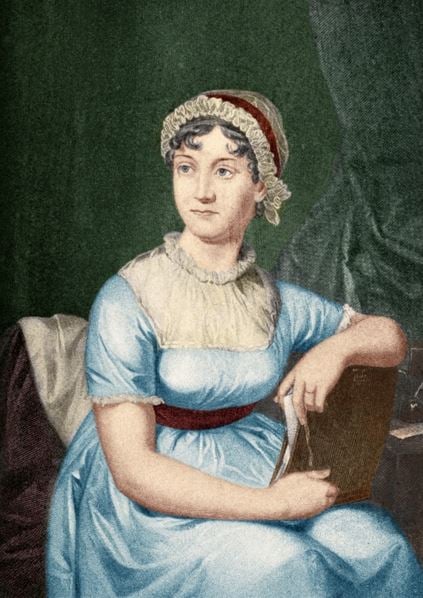
Jane Austen (1775-1817) illustration from ‘Little Journeys to the Homes of Famous Women’, published 1897 (engraving) (later colouration), English School, (19th century) / Private Collection / Photo © Ken Welsh
Childhood
Jane Austen was a particularly welcome arrival for her family; born a month late, she served as a close female companion for her one sister Cassandra, in a family that had already reared six brothers. She was born in Steventon, Hampshire, on the 16th of December 1775. Though rural Hampshire was a somewhat placid atmosphere for Jane’s upbringing, her aunt Philadelphia’s tales of exotic travels and fashionable London life helped to widen her horizons and influence her later life and works.
Jane and her sister were sent to Oxford to study as young children, but within a few months there they both caught typhus and Jane nearly died. Luckily she escaped a tragic ending and went on to be home schooled and then educated at the Abbey School House, ruled by a woman with a cork leg and a passion for theatre. However, it wasn’t long before her education was again disrupted – this time due to the school fees being too expensive for the Austens. After 1786, Austen ‘never again lived anywhere beyond the bounds of her immediate family environment.’
Jane, the Dramatist and Writer
Private theatricals were an important part of Jane’s learning and family and friends would often stage plays in the rectory barn. Most of these were comedies, which could explain how Jane’s satirical gifts were cultivated. At just 12 years of age she had a go at her first dramatic writing; she wrote three short plays during her teenage years. From early on her stories were full of ‘anarchic fantasies of female power, licence, illicit behaviour, and general high spirits’, according to Janet Todd. She often mocked popular novels of sensibility and also had unique access to her brothers’ schoolbooks and her father’s library. Books were an expensive luxury at the time – a new piece of fiction would’ve cost around £100 at today’s prices! It is believed that Austen loved to read Mills & Boon novels, as well as work by Samuel Richardson, Ann Radcliffe, Frances Burney and Marie Edgeworth, among others.
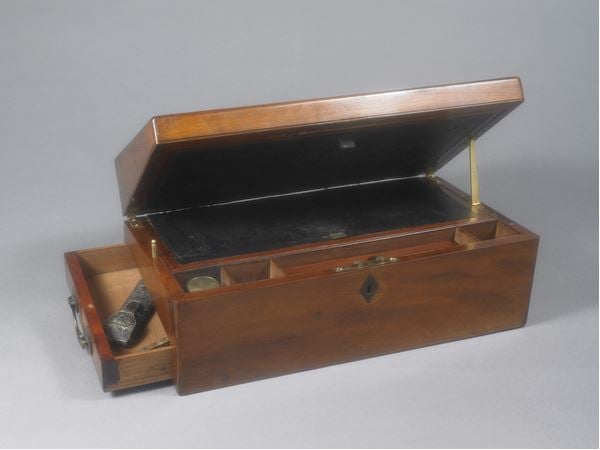
Portable writing desk that belonged to Jane Austen. Lid slightly open, and drawer out. / British Library, London, UK / © British Library Board. All Rights Reserved
By the age of 23, Austen had already finished the original versions of her famous Northanger Abbey, Sense and Sensibility, and Pride and Prejudice. Six of her novels were published in total – in addition to the former three, she wrote Mansfield Park, Emma and finally, Persuasion. Yet, the four books that were published in Austen’s lifetime were all credited anonymously; Sense and Sensibility was ‘By a Lady’, while Pride and Prejudice was credited to ‘The Author of Sense and Sensibility’.
Love-lost
Austen never married, although she once accepted a marriage proposal from the wealthy brother of a close friend, Mr Harris Bigg-Wither, in December 1802. She turned him down the following day after coming to terms with the fact that she didn’t love him. Two letters to her sister Cassandra also mention a man named Tom Lefroy, whose presence in the writer’s life certainly seems to have been reflected in her Pride and Prejudice, as the courtship between Lefroy and Austen is said to have taken place over the year or so that the novel was written. Austen scholar Jon Spence mused that perhaps Lefroy’s gregarious personality was actually the model for the heroine Elizabeth Bennett and that Austen used her own measured demeanour for the male protagonist, Mr Darcy.
Austen describes Lefroy as a ‘very gentlemanlike, good-looking, pleasant young man’ in her letters, but the romance was not destined to be – ‘the day is come on which I am to flirt my last with Tom Lefroy, and when you receive this it will be over. My tears flow as I write at the melancholy idea.’
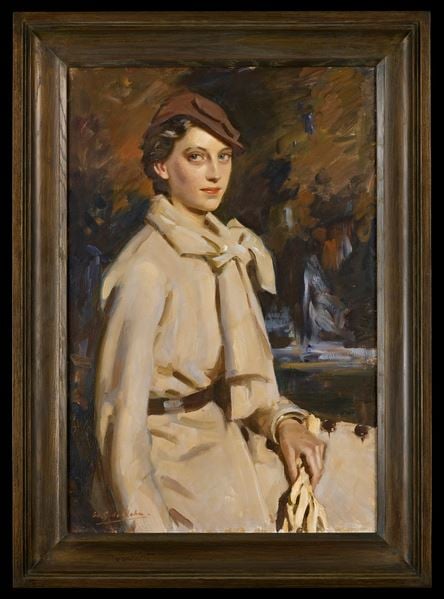
Portrait of Jane Austen in Beige, Autumn, 1930s (oil on canvas), Wilfred Gabriel de Glehn (1870-1951) / Private Collection / Photo © Philip Mould Ltd, London
Death, Legacy and a New Note
Austen died at the untimely age of 41 from an illness that amounted to a slow, painful decline in her physical condition. The type of illness has never been confirmed, but researchers have speculated that Hodgkin’s lymphoma, bovine tuberculosis, or a delayed relapse of the epidemic typhus she had as a child could be strong possibilities.
After Austen’s death, members of her family arranged for the publication of Persuasion and Northanger Abbey as a set. Henry Austen contributed a loving Biographical Note which, for the first time, identified his sister as the author of the novels. Sales were good for a year – only 321 copies remained unsold at the end of 1818. After that, her novels entered regular publication and Jane Austen became a household name.
Austen is remembered today as one of the best writers in British history. This year she will replace Charles Darwin to become the face of the new Bank of England £10 note – becoming the only other woman besides the Queen to feature on current UK currency and helping to avoid the long-term absence of women represented on banknotes. That being said, some campaigners are complaining that the image being used for the note is an author publicity portrait after she died, in which she’s been given the Georgian equivalent of an airbrushing. It contrasts this original sketch on which the portrait is based, by her sister Cassandra, which shows her with thin lips, a pointed chin, and bags under her eyes. The sketch is the only confirmed portrait of Austen to have been made during her lifetime and is on display at the National Portrait Gallery in London.
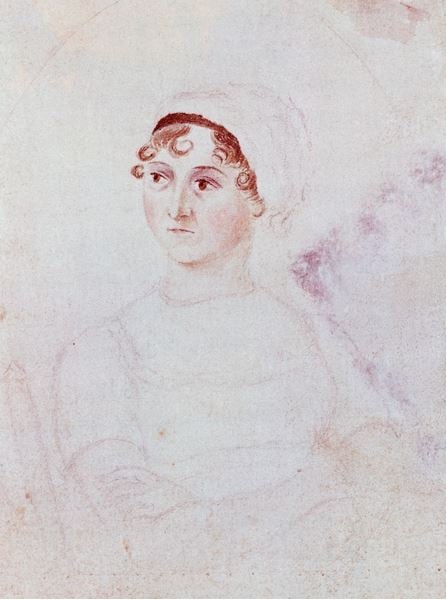
Portrait of Jane Austen, c.1810 (pencil & w/c on paper), Cassandra Austen (c.1772-1845) / National Portrait Gallery, London, UK / De Agostini Picture Library
Find out More
Contact us at uksales@bridgemanimages.com for more information on licensing and copyright
View all images relating to Jane Austen in the archive
Read more: Because of women…

